Oral Cysticercosis- A Diagnostic Dilemma
Pavan G. kulkarni1, Pavan Palakurthy2, Keerthi Muddana3, Rateesh Kumar Nandan4
1Reader, Department of Oral Pathology, Kamineni Institute of Dental Sciences, Narketpally, Nalgonda, Telangana, India.
2Post Graduate, Department of Oral Pathology, Kamineni Institute of Dental Sciences, Narketpally, Nalgonda, Telangana, India.
3Senior Lecturer, Department of Oral Pathology, Kamineni Institute of Dental Sciences, Narketpally, Nalgonda, Telangana, India.
4Professor and Head of Department, Department of Oral Pathology, Kamineni Institute of Dental Sciences, Narketpally, Nalgonda, Telangana, India.
NAME, ADDRESS, E-MAIL ID OF THE CORRESPONDING AUTHOR: Dr. Pavan G Kulkarni, Reader, Department of Oral Pathology, Kamineni Institute of Dental Sciences, Narketpally, Nalgonda – 508254, Telangana, India.
E-mail:drpgkulkarni@rediffmail.com
Cysticercosis, a helminthic disease commonly seen in India, Latin America, Eastern Europe and Southern Africa, results from extraintestinal encystation of the larval form of Taenia solium. It is a condition in which man acts as intermediate host instead of definitive host. The most frequent sites of cysticercosis are subcutaneous layers, brain, muscles, heart, liver, lungs, and peritoneum. Oral cysticercosis is considered rare and cause cystic swellings or nodules in the mouth and a precise clinical diagnosis is not usually established. Here, we report a case of oral cysticercosis in a 32-year-old female occurring in the mentalis muscle presenting as asymptomatic nodule.
Cysticercus cellulosae, Mentalis muscle, Taenia solium
Case Report
A 32-year-old female presented with the complaint of swelling in the lower lip region since five months. Patient gave a history of painless swelling which was insidious in onset and progressed in size for two months and then became static. Past medical history, dental history and family history were non contributory. Patient was not under any medication and no drug allergy. On extraoral examination, a solitary diffuse swelling of size 2x1.5 cm was seen on the left chin region extending from midline to corner of lower lip, oval in shape and the skin over the swelling was stretched and shiny [Table/Fig-1]. On palpation, the swelling was firm in consistency, non tender, mobile and there was no local rise of temperature. On intraoral examination, a solitary nodule is seen in the left anterior lower vestibule region extending from 31 to 33, normal in colour and obliterating the vestibule. On palpation the nodule was firm in consistency and nontender [Table/Fig-2]. Based on these findings a clinical diagnosis of mucocele was made and a differential diagnosis of minor salivary gland tumour and fibroma was given.
Orthopantamogram (OPG) did not show any bony changes. Magnetic resonance imaging (MRI) showed an irregularly marginated, well-encapsulated, low attenuation, peripherally enhancing cyst within the mentalis muscle. It showed an eccentrically located focus of different signal characteristics [Table/Fig-3]. Routine blood investigations were done which did not show any significant values. Enucleation of the cystic lesion in toto was performed under local anesthesia and sent for histopathological examination.
Gross specimen was measuring about 2x2x1.5 cm in size, soft in consistency, brownish black in color and roughly oval in shape [Table/Fig-4]. On longitudinal section, specimen showed a cystic cavity containing clear fluid and a white mass attached at one end of the cavity [Table/Fig-5].
Haematoxylin & Eosin Staining was done and under hispathological examination, the section revealed a fibrous capsule infiltrated by chronic inflammatory cells. The cystic space showed scolex of the larva attached to one end of the double layered cystic membrane [Table/Fig-6, Table/Fig-7]. The cystic lining showed outer cellular and inner sparsely cellular areas [Table/Fig-8]. Based on the findings (MRI, gross and histopathology) cysticercosis was confirmed.
Diffuse swelling on the left side of the chin
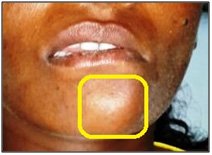
Solitary nodule present intraorally extending from 31 to 33
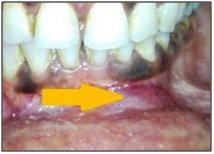
MRI showing a cystic lesion in the mentalis muscle
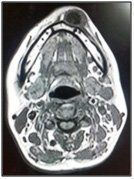
Gross specimen of the excised cystic lesion
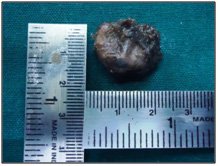
Longitudinal section of the specimen showing fibrous wall and cystic cavity
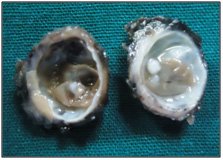
H&E (4x) Showing the scolex of the larva and the cystic lining
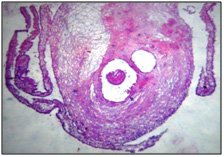
H &E (10x) Showing scolex attached to the double layered cystic lining
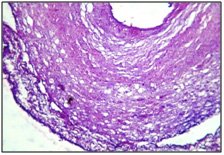
H &E (40x) Showing double layered cystic lining with outer cellular and inner sparsely cellular layer
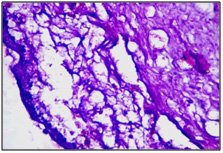
Life cycle of Taenia solium
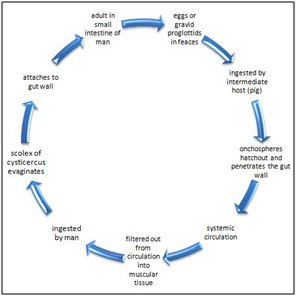
Discussion
Cysticercosis was first described in pigs by Aristophanes and Aristotle in 3rd century BC. Later it was noticed in humans by Parunoli in 1550. Pork tape worm (Taenia solium) infection is endemic in many parts of the world including India, Russia, China, Pakistan, Philippines, Indonesia and Mexico [1].
Life cycle of T. solium is complex requiring two mammalian hosts: a definitive host to reach sexual maturity, and an intermediate host. Humans are the only definitive hosts for the adult T. solium and pigs are the intermediate hosts [2]. Cysticercus cellulosae, the larval stage of T. solium, resides in muscles and other tissues in pigs. Taenia eggs may be ingested through the consumption of raw or undercooked pork, contaminated water, and vegetables or by autoinfection [3]. The eggs develop into oncospheres that penetrate the intestine wall and via lymphatic or vascular circulation reach a destination where the larvae develop into cysticerci or “bladder worm” [4]. Life cycle of T. solium is shown [Table/Fig-9] [5].
The most frequent sites of cysticercosis infection include subcutaneous layers, brain, muscles, heart, liver, lungs, and peritoneum[4]. Oral involvement of cysticercosis is rare and in the oral cavity frequently involved sites are the tongue (42.15%), followed by the lips (26.15%) - with the lower lip accounting for 64.7% of those and the buccal mucosa (18.9%) [4]. Presence of multiple intra oral cysticercosis is not uncommon. Jay et al., reported multiple intraoral nodules involving labial, buccal and lateral lingual mucosa [6]. Kumar et al., reported a case of cysticercosis involving masseter [2]. Jaya Joshi et al., reported a case of cysticercosis occurring in the mucobuccal fold of maxillary canine [7]. Mentalis muscle was involved in the present case which has not been reported earlier in the literature.
Patients with oral cysticercosis report swelling as the chief complaint rather than pain [4]. Pain is usually seen in cases with secondary infection. In the present case also patient complained of an asymptomatic swelling which remained constant in size and did not show any changes.
In the present case, patient had no habit of eating pork. So, the mode of infection in the present case could be due to poor life style and hygiene habits. Differential diagnosis of oral cysticercosis usually depends on the site involved. In the present case nodular swelling was present in the lower lip, a differential diagnosis of mucocele, fibroma and benign salivary gland neoplasm were considered.
Diagnosis of cysticercosis can be confirmed using magnetic resonance imaging, computerized tomography especially for cases of neural cysticercosis, serological methods and tissue biopsy [8]. Immunological diagnosis of cysticercosis can be made from serum, cerebrospinal fluid and saliva using enzyme linked immunosorbent say (ELISA) or enzyme-linked immunoelectrotransfer Blot (EITB) [4]. FNAC is a valuable aid in the early diagnosis of cysticercosis and the cytomorphology is seen as inflammatory foreign body granulomatous reaction [9]. In the present case histopathology confirmed the diagnosis of cysticercosis by the detection of cysticercus cellulosae in the cystic space.
The treatment includes surgical enucleation and potent antihelmenthics like praziquantel and albendazole. Drugs should be used especially in symptomatic patients, disseminated cysticercosis, and cases where surgical treatment is risky or not possible, as in neurocysticercosis [3].
Conclusion
It is important to consider the diagnosis of cysticercosis in oral lesions which present as single nodules in patients belonging to endemic areas. Once the diagnosis of cysticercosis is made further evaluation should be done to check for the involvement of other regions of the body to avoid complications.
[1]. KN Prasad, A Prasad, A Verma, AK Singh, Human cysticercosis and Indian scenario- A reviewJ Biosci 2008 33(4):571-82. [Google Scholar]
[2]. BD Kumar, B Dave, SM Meghana, Cysticercosis of masseterIndian J Dent Res 2011 22(4):617 [Google Scholar]
[3]. ACP Ribeiro, MC Luvizotto, AMP Soubhia, AL de Castro, Oral cysticercosis: case reportOral Surg Oral Med Oral Pathol Oral Radiol Endod. 2007 104(4):e56-58. [Google Scholar]
[4]. FM Elias, MT Martins, R Foronda, WA Jorge, NS Araujo, Oral cysticercosis: case report and review of the literature.Rev Inst Med Trop Sao Paulo. 2005 47(2):95-8. [Google Scholar]
[5]. Baveja CP, Text book of Microbiology 2013 3344th EdParasitology. [Google Scholar]
[6]. A Jay, J Dhanda, PL Chiodini, CJ Woodrow, PM Farthing, J Evans, Oral cysticercosisBritish Journal of Oral and Maxillofacial Surgery 2007 45(4):331-34. [Google Scholar]
[7]. J Jaya, BS Manjunatha, J Rameshwar, K Shaleen, Oral cysticercosis: a diagnostic difficulty.Journal of Clinical and Diagnostic Research 2014 8(10):24-25. [Google Scholar]
[8]. CR Sudhapalli, S Himanshu, KN Vinay, KC Vidya, Oral cysticercosis- a case reportInt. Journal of Clinical Dental Science 2011 2(4):36-39. [Google Scholar]
[9]. M Sujit, A Poonam, D Abhay, B Rajeev, Oral cysticercosis- a case reportJ Maxillofac Oral Surg 2009 8(1):85-87. [Google Scholar]